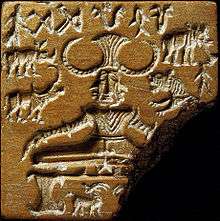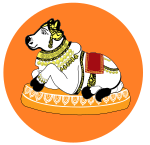Pashupati
Pashupati (Sanskrit Paśupati; devanagari पशुपति ) is an incarnation of the Hindu god Shiva as "lord of the animals". He is revered by Shaivites throughout the Hindu world In general Pashupatinath means lord of all animals.
| Pashupati | |
|---|---|
Lord of the Animals | |
 The Pashupati seal from Indus Valley is purported by some section of scholars as, proto-Shiva | |
| Affiliation | Incarnation of Shiva |
| Region | India and Nepal |
| Part of a series on |
| Shaivism |
|---|
 |
|
Scriptures and texts
|
|
Philosophy
|
|
Practices |
|
Schools
Saiddhantika Non - Saiddhantika
|
|
Related
|
Etymology
Paśupati "Lord of all animals" was originally an epithet of Rudra in the Vedic period[1] and now is an epithet of Shiva.[2]
The Deity
Pashupatinath is an avatar of Shiva, one of the Hindu Trinity. He is the masculine counterpart of Shakti.
The five faces of Pashupatinath represent various incarnations of Shiva; Sadyojata (also known as Barun), Vamdeva (also known as Uma Maheswara), Tatpurusha, Aghor & Ishana. They face West, North, East, South and Zenith respectively, and represent Hinduism's five primary elements namely earth, water, air, light and ether.[3]
Puranas describe these faces of Shiva as [3]
Sadyojata, Vamdeva, Tatpurusha & Aghora are the four faces, The fifth is Ishana, unknowable even to the seers
Nepal

Though Nepal is an officially secular state, its population is predominantly Hindu, and Lord Shree Pashupatinath is revered as a national deity. The Pashupatinath Temple, located at the bank of the river Bagmati, is considered as the most sacred place in Nepal. The mythology hold that Lord Pashupatinath started living in Nepal in the form of a deer, then when he saw the Kathmandu Valley and he was overwhelmed by its beauty.
India

A Pashupatinath temple is sited on the banks of the Shivana river in Mandsaur, Madhya Pradesh, India. It is one of the most prominent shrines in Mandsaur, and Lord Shiva in the form of Lord Pashupatinath is its primary deity. Its main attraction is a unique Shiva Linga displaying eight faces of Lord Shiva. The shrine has four doors, representing the cardinal directions.[4]
Notes
- Kramrisch, p. 479.
- Śarmā 1996, p. 291.
- Encyclopaedia of Saivism, Swami P. Anand, Swami Parmeshwaranand, Publisher Sarup & Sons, ISBN 8176254274, ISBN 9788176254274, page 206
- Pashupatinath Temple website Archived 2013-05-30 at the Wayback Machine
References
- Flood, Gavin (1996). An Introduction to Hinduism. Cambridge: Cambridge University Press. ISBN 0-521-43878-0.
- Flood, Gavin (Editor) (2003). The Blackwell Companion to Hinduism. Malden, Massachusetts: Blackwell. ISBN 1-4051-3251-5.CS1 maint: extra text: authors list (link)
- Kramrisch, Stella (1981). The Presence of Śiva. Princeton, New Jersey: Princeton University Press. ISBN 0-691-01930-4.
- Michaels, Axel (2004). Hinduism: Past and Present. Princeton, New Jersey: Princeton University Press. ISBN 0-691-08953-1.
- Possehl, Gregory (2003). The Indus Civilization: A Contemporary Perspective. AltaMira Press. ISBN 978-0-7591-0172-2.
- Śarmā, Rāmakaraṇa (1996). Śivasahasranāmāṣṭakam : eight collections of hymns containing one thousand and eight names of Śiva. Delhi: Nag Publishers. ISBN 9788170813507. OCLC 36990863.CS1 maint: ref=harv (link) Includes Śivasahasranāmakoṣa, a dictionary of names. This work compares eight versions of the Śivasahasranāmāstotra. The preface and introduction (in English) by Ram Karan Sharma provide an analysis of how the eight versions compare with one another. The text of the eight versions is given in Sanskrit.
- Zimmer, Heinrich (1972). Myths and Symbols in Indian Art and Civilization. Princeton, New Jersey: Princeton University Press. ISBN 978-0-691-01778-5.
